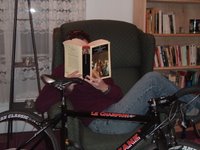Emily asked in a comment a few days ago whether, since I've taken to reading a bunch of books at once, the books are in conversation with one another -- whether I'm finding that the books connect. Well, yes I am, as a matter of fact. I'm finding that (and this will probably surprise no one) Proust is the most voluble among them.
Stefanie wrote a post on the Proust blog Involuntary Memory about the way memories are wrapped up in objects, and encountering an object, such as the madeleine, can involuntarily conjure up a powerful memory. Objects hold the key to our past; Stefanie says:The taste or smell or feel of an object can unlock a memory in such a way that one is transported back in time to relive it. But finding the key is purely chance, if we don't encounter the right object before we die, then we will never experience whatever memory that object is the key to. We don't even know what the keys look like though so we can't even search for them.
For Proust, objects can tell us who we are. We look to them to hold our memories and we are indebted to them for the way they reveal things about us.
I also came across this passage from Proust in his long and beautiful description of the church at Combray, and particularly the steeple, the thing in the center of his town, what holds it together and unifies it. He talks about what the steeple means to him and to his grandmother:
Here, the steeple comes alive or seems to come alive; it seems to become self-aware, it speaks for the church. And the grandmother responds emotionally, effusing with the spire, seeming to soar with it. Objects and people blend; people experience memories through objects and their emotions are evoked and strengthened through them. And objects participate, or seem to participate, coming alive as they inspire people to life.
Without really knowing why, my grandmother found in the steeple of Saint-Hilaire that absence of vulgarity, of pretension, of meanness, which made her love and believe rich in beneficent influence not only nature, when the hand of man had not, as my great-aunt's gardener, shrunk and reduced it, but also works of genius. And certainly, every part of the church that one could see distinguished it from all other buildings by a sort of thoughtfulness that was infused into it, but it was in the steeple that it seemed to become aware of itself, affirm an individual and responsible existence. It was the steeple that spoke for it ... And looking at it, following with her eyes the gentle tension, the fervent inclination of its slopes of stone, which approached each other as they rose like hands meeting in prayer, she would join so fully in the effusion of the spire that her gaze seemed to soar with it ...
Then I read this poem by Jane Hirschfield, called "Rock":
What appears to be stubbornness,
refusal, or interruption
is to it a simple privacy. It broods
its one thought like a quail her clutch of eggs.
Mosses and lichens
listen outside the locked door.
Stars turn the length of one winter, then the next.
Rocks fill their own shadows without hesitation,
and do not question silence,
however long.
Nor are they discomforted by cold, by rain, by heat.
The work of a rock is to ponder whatever is:
an act that looks singly like prayer,
but is not prayer.
As for this boulder,
its meditations are slow but complete.
Someday, its thinking worn out, it will be
carried away by an ant.
A Mystrium camillae,
perhaps, caught in some equally diligent,
equally single pursuit of a thought of her own.
How different are the objects in this poem than in Proust! The rock resists getting pulled into the world of the human; it is merely itself, nothing else. It is not stubborn; it does not refuse; it merely does its one job, to be what it is. In doing this job, it may look like it is praying, but it is not. Rocks have no self-consciousness; they simply "fill their own shadows," unlike humans who must think about what it is they are doing and why they are doing it.
So Proust seems to be interested in the ways objects help people experience the world and blur the boundaries between human and non-human, and Hirschfield in the ways objects are separate from the human world, as entities unto themselves. And yet this distinction isn't quite true either; Proust keeps using the word "seems," the steeple seems to become aware of itself, as if to recognize that this "seeming" comes from Proust's imagination, and Hirschfield says that the rocks ponder and meditate and think, as humans do. Perhaps it is the rocks who have the greater degree of aliveness, since for Hirschfield they are doing a job; their existence is a form of work. The steeple begins to take on meaning when humans get involved; the rocks have meaning in and of themselves.
So this is what my books are talking about: the line between humans and objects, the existence of objects outside the world of the mind and the way objects enter the mind, somehow, to tell us who we are.
Proust has been talking with Muriel Spark, too; one of these days I'll write about that conversation.



|